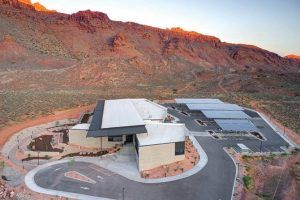As the subject of sustainability has become increasingly prevalent throughout governments, businesses, and communities, the question is asked, over and over: does my personal commitment to sustainability really make a difference? Those who argue that sweeping changes by governments and major corporations are the only way our society will make significant progress toward a more sustainable future have a compelling argument.
For instance, it is estimated that anywhere between 40% and 50% of global greenhouse gas emissions come from the building sector, including energy use and embodied carbon; approximately 2.7 billion people on the planet face water scarcity, a number that continues to increase substantially; and poor air quality disproportionately affects those in developing counties, contributing to a reduction in life expectancy of up to seven years in some countries.
These are complex and far-reaching issues that individuals are not equipped to solve on their own. However, many of those in this camp have completely dismissed the idea of personal responsibility, arguing that it is nothing more than a distraction that takes the pressure off governments to take substantive action and shifts blame from major corporate polluters onto individuals.
Admittedly, there is a limit to the impact of individual actions, and top-level, systematic change is necessary, but as long as individuals and governments continue to point fingers at one another to take action, society will continue on its unsustainable course. Sustainability is not a zero-sum game. People can recognize the pollution plastic grocery bags create and take steps to use reusable bags in their personal lives while also supporting public policy to ban plastic bags. Problems such as air quality, water scarcity, and carbon emissions in the built environment require top-down and bottom-up approaches working together towards innovative, lasting solutions. As individuals make behavioral changes that lead to a more sustainable lifestyle, they are helping to raise awareness around the issues so that others might follow suit, holding corporations and governments more accountable through individual purchasing and voting power and beginning to lay the foundation for a sustainable society. To paraphrase John F. Kennedy, individual actions can create ripples that become powerful currents.
In 2021, Singapore, a global leader in sustainable building solutions, published a national sustainability commitment called the Singapore Green Plan 2030. The plan outlines specific targets, including emissions reduction goals, carbon sequestration projects, renewable energy goals, and waste reduction targets, that will accelerate the nation’s progress toward building a net-zero, sustainable society.
Meanwhile, a 2022 survey conducted in Singapore revealed that not only are many citizens not making individual behavioral choices that complement the government’s sustainability initiatives, but those in the youngest generation surveyed, Generation Z, have actually regressed in many areas. They travel by air more often, purchase more non-essential items, consume more meat, and generally make fewer “green” choices than the previous year. This underscores the importance of individual efforts to work in tandem with public policy and help government initiatives succeed.
Because the building sector is a major contributor to greenhouse gases, making significant changes in the industry can seem daunting, but with such vast potential for improvement, those working in the industry have the opportunity to lead out and walk the talk of sustainability, both through individual efforts and approach to project design. Setting this example — void of any form of moral superiority — within the industry, throughout communities and neighborhoods, and even within one’s own circle of family and friends can have a significant impact. It might also draw attention to the most pressing issues facing a community. The visual impact of a water-wise landscape in a front yard can remind neighbors of the ongoing drought, encourage others to save water, or prompt a phone call or email to government representatives demanding action on water issues.
Other simple yet effective personal actions might include making a strong effort to reduce waste, especially single-use plastic, while diverting as much as possible to recycling or composting bins. Supporting local farmers or growing a backyard garden can help improve food security and reduce emissions. Upgrading to energy-efficient appliances in homes and workplaces will reduce overall energy consumption, and using public transportation or cycling helps improve poor air quality.
Sustainable architectural design is becoming more prevalent, more achievable, and more affordable. In fact, “green” buildings are around 15% less expensive to operate and maintain. Design teams understand the many benefits of sustainable buildings and have the opportunity to communicate these benefits to owners. Additionally, they have the opportunity to play a role in enabling individual sustainability efforts. For example, a sustainable building design might encourage building users to minimize waste by making recycling and composting more accessible, automating the process, or even finding a way to help increase the building users’ trust in the recycling process. Another project might benefit from visual reminders to occupants of sustainable building components that could be repeated in their own homes, such as a small section of solar panels placed within public view or a rooftop vegetable garden tended by the building users.
The challenge for design teams is to embed sustainability within every project and to do so in a way that shows sustainability to be simple and accessible for everyone while moving the industry toward a collective mindset shift that will become part of a sustainable revolution.
Why The Building Sector? – Architecture 2030. (n.d.). Retrieved September 23, 2022, from
https://architecture2030.org/why the-building-sector/
Water Scarcity | Threats | WWF. (n.d.). World Wildlife Fund. Retrieved September 23, 2022, from https://www.worldwildlife.org/threats/water-scarcity
World’s worst air pollution slashes seven years off life expectancy in Bangladesh. (2022, June 16). Mongabay Environmental News. Retrieved September 23, 2022, from https://news.mongabay.com/2022/06/worlds-worst-air-pollution-slashes-7-years-off-life-expectancy-in-bangladesh/
Singapore Green Plan 2030 | Overview. (n.d.). Retrieved September 23, 2022, from https://www.greenplan.gov.sg/key-focus-areas/overview
Lee, L. (2022, August 17). Baby boomers in Singapore more environmentally conscious, leading greener lifestyles than younger generations: Study. TODAY. Retrieved September 23, 2022, from https://www.todayonline.com/singapore/baby-boomers-singapore-more-environmentally-conscious-leading-greener-lifestyles-younger-generations-study-1970726
Elizabeth Currey has more than 15 years of experience in the AEC industry and holds a master’s degree in Sustainability Leadership from Arizona State University. She leads sustainability efforts at VBFA, a full-service MEP firm specializing in sustainable, energy-efficient MEP systems engineering.







